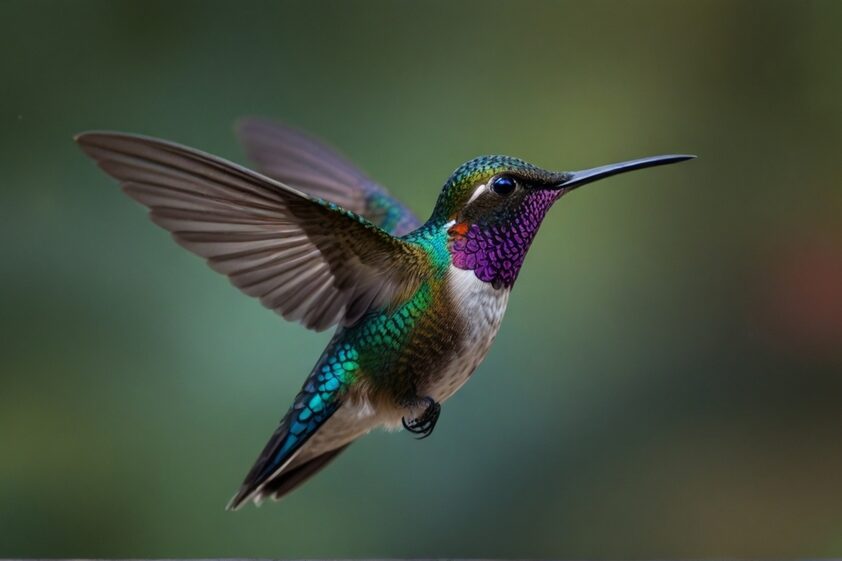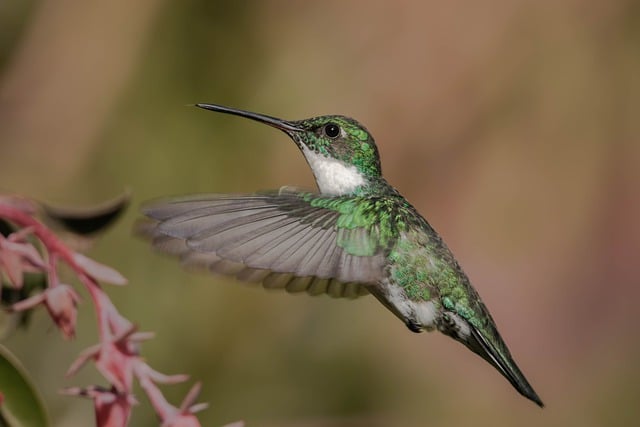1. They Have the Fastest Heartbeat in the Bird World

Imagine drinking six espressos and then running a marathon—now you’re living the hummingbird lifestyle! These tiny speedsters can rev their hearts up to 1,260 beats per minute, which is so fast that if you tried to count, you’d be out of breath before you hit 10. To put that in perspective, a human’s resting heart rate is around 60-100 beats per minute, and even during intense exercise, it rarely goes above 200. If a hummingbird’s heart slowed down to our pace, it would probably keel over from exhaustion in minutes. Their little engines are running on overdrive 24/7, and yet they somehow manage to make it all look effortless.
2. They Can Hover Like a Helicopter—And Then Some

Most birds flap their wings up and down, but hummingbirds take it to the next level by rotating their wings in figure-eight patterns, allowing them to hover, fly backward, and even zip upside-down for short bursts. It’s as if they saw how regular birds fly and said, “That’s cute, but let’s make it harder.” Their wing movements are so precise that they can stay perfectly still in mid-air, like tiny, feathered drones. Scientists have even studied their flight mechanics to improve robotic flying technology—yes, humans are literally taking engineering notes from these guys. If hummingbirds ever get tired of the whole nectar-drinking thing, they could probably make a decent living as stunt pilots.
3. They Weigh Less Than a Penny

A U.S. penny weighs 2.5 grams, yet the smallest hummingbird—the bee hummingbird—weighs in at just 1.6 grams. That means you could carry an entire handful of these birds in your pocket and still have room for your keys and a snack. Despite their minuscule size, they have an energy output that rivals Olympic athletes, flapping their wings up to 80 times per second and zooming around at speeds of up to 30 miles per hour. If a human had the same power-to-weight ratio as a hummingbird, we’d be able to outrun a cheetah and take off into the sky like Superman. Instead, we get tired walking up a flight of stairs—life’s just not fair.
4. Their Wings Flap at an Insane Speed

While you’re still trying to blink, a hummingbird has probably flapped its wings 200 times. Some species reach speeds of 80 beats per second, making their wings look like a total blur. That’s so fast that you can actually hear the characteristic humming sound they make—which, surprise, is where they get their name. If you tried to move your arms at the same rate as a hummingbird’s wings, you’d either dislocate both shoulders or spontaneously combust from the sheer effort. Meanwhile, these tiny dynamos do it all day, every day, like it’s no big deal.
5. They Have an Off Switch for Their Metabolism

Hummingbirds live life in the fast lane, but at night, they hit the brakes—hard. They enter torpor, a hibernation-like state where their heart rate plummets from 1,200 beats per minute to as low as 50. Their body temperature also drops dramatically, sometimes reaching near-freezing levels. This temporary shutdown helps them conserve energy, especially during cold nights or when food is scarce. If humans had the ability to do this, we could literally take power naps that felt like full nights of sleep, but instead, we’re stuck with groggy mornings and overpriced coffee.
6. They Eat Their Weight in Food Every Day

Imagine needing to eat 10 times your body weight in food every single day just to stay alive. Hummingbirds do just that, consuming up to 8 times their weight in nectar daily—that’s like a human drinking a bathtub full of soda just to make it through lunch. To fuel their high-speed lifestyle, they visit up to 1,500 flowers per day, slurping up sugary nectar with their super-speedy tongues. On top of that, they also snack on tiny insects and spiders for extra protein. If they go just a few hours without food, they can literally starve to death, making their entire existence a constant battle against the clock.
7. They Have Tiny but Mighty Brains

You’d think a bird that weighs less than a grape wouldn’t have much going on upstairs, but hummingbirds actually have the largest brain-to-body ratio of any bird. Their tiny brains account for 4.2% of their total body weight, which is proportionally bigger than a human brain. They use this brainpower to map out the locations of their favorite flowers and remember exactly how long it takes for each one to refill with nectar. They can also recognize human faces, so if you ever forget to refill your backyard feeder, don’t be surprised if a hummingbird gives you the stink eye. Meanwhile, I can’t even remember where I put my phone five minutes ago.
8. They Can See Colors You Can’t

Think you’re seeing all the colors in the world? Think again. Hummingbirds can detect ultraviolet (UV) light, which means they see colors that are completely invisible to the human eye. Flowers that look plain to us are probably glowing like neon signs to them, making it easier for them to find food. Scientists have even tested this by showing them “impossible” colors—combinations like ultraviolet-green and ultraviolet-red—and they can differentiate them effortlessly. Meanwhile, we struggle to match our socks in the morning.
9. Their Tongues Work Like Tiny Pumps

A hummingbird’s tongue isn’t just a simple straw—it’s a high-speed nectar pump. Their forked tongues curl up when they touch liquid, trapping nectar inside, and then they rapidly slurp it up at a rate of 20 licks per second. That’s faster than a dog lapping up peanut butter! Their tongues are also twice as long as their beaks, allowing them to reach deep into flowers for the good stuff. If humans had tongues like this, we’d probably be banned from every buffet in town.
10. They Have Built-In Jet Fuel

Hummingbirds don’t just burn energy—they incinerate it at a rate that would put human metabolism to shame. Their tiny bodies are designed to run on pure sugar, and they can convert nectar into usable energy almost instantly. Unlike humans, who take time to digest food and store energy in fat, hummingbirds burn through their meals within minutes. This means they need a constant supply of fuel or risk running out of energy entirely. If we had their metabolism, we could eat a whole pizza and immediately sprint a marathon—no carb-loading necessary. Instead, we eat a whole pizza and immediately fall asleep on the couch.
11. They Can Outfly Jets (Sort Of)

A ruby-throated hummingbird migrates 500 miles non-stop across the Gulf of Mexico. No pit stops. No breaks. Just straight-up flapping for 18 hours. To put this into perspective, that’s like running multiple back-to-back marathons without a single water break. They don’t even use the wind to glide like other birds do—hummingbirds are pure muscle, beating their wings constantly just to stay airborne. Scientists have tracked these migrations and found that some of these tiny birds take off from the coast of the U.S. and don’t stop flying until they reach Mexico. If a human had to do this, we’d collapse after about five minutes. And yet, these little guys make the journey like it’s just another Tuesday. Meanwhile, I need a full recovery day after walking too much at the mall.
12. They Battle Each Other Like Tiny Gladiators

For such tiny creatures, hummingbirds are shockingly aggressive. Despite their delicate, fairy-like appearance, these birds are basically feathered warriors. Males will dive-bomb, chase, and even body-slam rivals to defend their favorite flowers and feeding spots. Some species are known to stab each other with their needle-like beaks in mid-air duels that look straight out of an action movie. They don’t just fight for food, either—hummingbirds are fiercely territorial when it comes to potential mates. If another bird dares to trespass into their space, expect a high-speed aerial showdown. Some hummingbird species have even evolved dagger-shaped beaks specifically for battle. Imagine if humans had to fight off intruders at every meal—dinner time would be absolute chaos.
13. They Have Sparkly Feathers, But It’s an Illusion

Hummingbirds might look like they were designed by a particularly artistic wizard, but their shimmering, iridescent feathers aren’t actually colored the way you think. Unlike most birds, whose colors come from pigments, a hummingbird’s dazzling hues are created by microscopic platelets in their feathers that reflect and refract light. This means their colors change depending on the angle, making them look like tiny, flying rainbows. One second, a male hummingbird might look emerald green, the next he’s a deep sapphire blue. It’s basically nature’s version of a hologram. If humans had this ability, fashion would be next-level—we could wear the same outfit every day and just tilt our heads for a brand-new color scheme.
14. They’ve Been Around Since the Dinosaurs

Hummingbirds may seem futuristic with their high-speed wings and turbocharged metabolism, but these little guys are ancient survivors. Fossil evidence suggests that hummingbirds have been around for at least 22 million years, and some researchers believe their ancestors may date back even further—possibly to the time of the dinosaurs. They originally evolved in South America and slowly spread to other parts of the world, adapting to different climates and food sources along the way. This means hummingbirds have outlived saber-tooth cats, woolly mammoths, and pretty much every apex predator that has ever existed. Meanwhile, we humans are still struggling to survive cold weather without five layers of clothing and a heated blanket.
15. They’re the Only Birds That Can Fly Backward—And That’s Just the Start

Most birds can only move forward, but hummingbirds operate like tiny aerial acrobats, zipping in every direction with absolute control. Not only can they hover like a helicopter, but they’re also the only bird species that can fly backward with ease. Need to retreat from a flower? No problem. Want to dart sideways? They can do that too. They can even perform mid-air flips and rolls like stunt pilots, all thanks to their unique ball-and-socket shoulder joints that allow them to rotate their wings in a full 360-degree range of motion. If humans could move like this, we’d never trip over anything again—or at the very least, we’d have some seriously cool dance moves.


